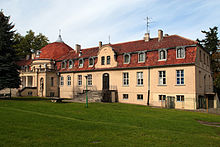Glisno (Lubniewice)
| Glisno | ||
|---|---|---|
 Help on coat of arms |
|
|
| Basic data | ||
| State : | Poland | |
| Voivodeship : | Lebus | |
| Powiat : | Sulęciń | |
| Gmina : | Lubniewice | |
| Geographic location : | 52 ° 29 ′ N , 15 ° 15 ′ E | |
| Residents : | 810 () | |
Glisno ( German Gleißen ) is a village in the powiat Sulęciński (Zielenzig district) in the Polish Lubusz Voivodeship . It is assigned to the Gmina Lubniewice .
Geographical location
Glisno ( Gleißen ) is located in the Neumark , six kilometers south of the small town of Koenigswalde ( Lubniewice ) and twelve kilometers north of the small town of Zielenzig ( Sulęcin ).
history
It was first mentioned in 1421. The center of the long agricultural village was a manor . Around 1790–93, the landlords had a palace built for themselves, which has strong echoes of Sanssouci Palace in Potsdam. In 1806, the then squire, District President of Poser, founded an alum factory that existed until 1854.
In 1818/19 the manor Gleißen was bought by Israel Moses Henochsohn , a Jewish citizen of Berlin who invested a lot in the place. In 1823 he founded a silk factory, whereupon in 1829 the last members of the silk weavers' guild moved from Frankfurt (Oder) to Gleißen. The factory was expanded as early as 1835 to 1838. In addition, home industry is developing in the area . Silkworm breeding flourished in the surrounding towns and mulberry plantations emerged.
Towards the end of the 18th century, a mineral spring was discovered in Gießen, the water of which was said to have medicinal properties. Later on, natural deposits of mineral coal sludge were found. From 1824 Enoch set up a spa around an iron spring. The castle now served as a spa house and luxury hotel.
Enoch donated a new church to the parish of the village based on plans by Karl Friedrich Schinkel , which was inaugurated in 1837.
In 1841 the textile factory and the estate were separated from each other.
From 1849 to 1856 the rule of Gleißen belonged to the Prussian captain Carl Friedrich Wilhelm von Müller.
In 1854, alum production was stopped, but silk production was expanded and modernized. A local coal deposit was used to supply energy, and a cable car transported the coal from the deposit to the factory.
In 1857 Hans Karl Otto von Wartenberg bought the estate, closed the spa business and modernized the farm. In 1910 the Wartenberg family had the castle extended by 13 meter long wings.
In 1922 the textile factory was converted from silk to linen production following a change in ownership.
In 1945 Gleißen belonged to the Oststernberg district in the Brandenburg administrative district of Frankfurt of the German Empire .
Towards the end of the Second World War , Gleißen was occupied by the Red Army in the spring of 1945 . Soon after, the village was placed under Polish administration. In the following years the inhabitants were expelled . Gleißen was renamed Glisno .
In 1946 a Polish state estate was officially established. The castle was initially the seat of the state estate, then from 1968 to 1978 it housed a branch of the Kaliska plush and velvet factory (Kaliska Fabryka Pluszu i Aksamitu). Since 1978, it was under the woiwodschaftlichen Agricultural Advisory Center in Lubniewice (Königswalde) , since 2005 it is used by the Agricultural Advisory Center of Lubusz.
Population numbers
- 1801: 497
- 1933: 1112
- 1939: 1054
Attractions
- Classicist church from 1837.
- Rococo palace from 1780, today used for gastronomy and as a conference venue.
Sons and daughters of the place
- Horst Müller (1923-2005), German author
literature
- Eduard Ludwig Wedekind : Sternbergische Kreis-Chronik. History of the cities, towns, villages, colonies, castles etc. of this part of the country from the earliest past to the present . Zielenzig 1855, pp. 232-235.
- Błażej Skazinski: Gleissen / Glisno. (Palaces and Gardens of Neumark - Zamki i ogrody Nowej Marchii, No. 7). Berlin 2012, ISBN 978-3-941675-37-7 .
Web links
- Place website (Polish)
- Gleissen / Glisno. on: deutsche-gesellschaft-ev.de
- Castle website (Polish)
Footnotes
- ↑ Glisno - Informacje dodatkowe. on: mapa.szukacz.pl (Polish)
- ^ Johann Friedrich John and Friedrich August Zeuschner: About the newly discovered mineral coal sludge in the mineral bath at Gleißen . Berlin 1824 ( e-copy ).
- ^ Friedrich August Zeuschner: The mineral and coal sludge bath at Gleissen near Zielenzig in Neumark . Berlin 1827 ( e-copy ).
- ↑ P. v. Scheven: Officer master roles and ranking lists of the Royal Prussian Emperor Franz Guard Regiment No. 2. Berlin 1894. Verlag Ernst Siegfried Mittler and Son.
- ↑ Prussia-Brandenburg mishaps . Volume 2, Berlin 1904, p. 308.
- ^ A b Michael Rademacher: German administrative history from the unification of the empire in 1871 to the reunification in 1990. oststernberg.html # ew33ostragleissn. (Online material for the dissertation, Osnabrück 2006).
- ↑ Jörg Lüderitz: Discoveries east of the Oder. On the way between Frankfurt, Skwierzyna and Żary. Trescher Verlag, Berlin 2005, ISBN 3-89794-082-5 , p. 71. ( Trescher travel series )


